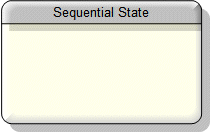Sequential state (dictionary item)

For automation interface information about a Sequential State, see
State (automation interface). For automation interface purposes, a Sequential State is a State that has its UML State Type set to Sequential.
A Sequential State can be decomposed into mutually exclusive States, called substates. In turn, a substate can be further decomposed. Decomposing a State in this way allows you to show its fine structure.
Within a Sequential State you must define an Initial State and Final State. Substates inherit the transitions of their Composite States, and a transition or action that applies to a state also applies to all its substates. The event that creates the object can also trigger a transition from the Initial State. An object that transitions to its outermost final state ceases to exist.
Create a Sequential State through a Modeler explorer pane or a State Diagram:
• In a Modeler pane, right-click a State Machine, Concurrent State or Sequential State, point to New, and then click Sequential State.
• On a State Diagram tab, click the  Sequential State button, and then click the diagram background (within the frame) or within a Sequential State.
Sequential State button, and then click the diagram background (within the frame) or within a Sequential State.
 Sequential State button, and then click the diagram background (within the frame) or within a Sequential State.
Sequential State button, and then click the diagram background (within the frame) or within a Sequential State.• On a State Diagram tab, click the  Concurrent Compartment button, and then within a Concurrent State.
Concurrent Compartment button, and then within a Concurrent State.
 Concurrent Compartment button, and then within a Concurrent State.
Concurrent Compartment button, and then within a Concurrent State.On a Sequential State you can create doActivities that are continuous performed by the Sequential State. A doActivity terminates when the Sequential State is complete, or when the Sequential State is exited. A doActivity can be an Activity, Operation or State Machine.
When used on a State Diagram, a Sequential State's notation is as follows.

The View Options on a State Diagram allow you to show or hide the Name, Event Action Blocks, Do Activities and Compartment Names. By default, all the preceding properties are shown. The view options are set through the Composite State entry.
Composite state view options - state diagram.
On a State Diagram, you can populate Sequential States: right-click the State Machine (frame) or Sequential State that owns the Sequential States, point to Populate, and then click Normal States. Note that all owned Sequential, Atomic, Concurrent and Submachine States are added to the diagram.
You can change a Sequential State into an Atomic State or Concurrent State: On the Sequential State's Property Pages, click the State Type tab, and then select the required type. You can change a Sequential State to a Concurrent State only if all the child items are Sequential States. When you change a Sequential State to an Atomic State, Modeler creates a child State Diagram.
You can change a Sequential State that owns one or more items into a Submachine: Right-click the Sequential State, and then click Convert to Submachine State. The command creates a new State Machine and State Diagram that is referenced by the Submachine State. The content of the Sequential State is moved to the new State Diagram. For example:

In the Dictionary pane, Sequential States are listed in the UML\States folder.
In the Modeler panes, a short-cut symbol  on the Sequential State's icon indicates that the item is a stub.
on the Sequential State's icon indicates that the item is a stub.
 on the Sequential State's icon indicates that the item is a stub.
on the Sequential State's icon indicates that the item is a stub.The following sections provide information about how a Sequential State is used in the model.
Properties
In addition to the standard properties a Sequential State has these properties:
State Type (UML State Type through the automation interface)
Owned by
 Atomic State (through child State Diagram)
Atomic State (through child State Diagram)Owns
 Dependency - The Dependency is owned jointly by the Sequential State and the other associated item. The access permissions you have to a Dependency are determined by the access permissions of the dependent item.
Dependency - The Dependency is owned jointly by the Sequential State and the other associated item. The access permissions you have to a Dependency are determined by the access permissions of the dependent item. Transition - The Transition is owned jointly by the Sequential State and the other associated item. The access permissions you have to a Transition are determined by the access permissions of the source item.
Transition - The Transition is owned jointly by the Sequential State and the other associated item. The access permissions you have to a Transition are determined by the access permissions of the source item.Defined in these parts of the model
Shown on these diagrams
Can be linked to these dictionary items
In addition to the owning State Machine or Sequential State, a Sequential State can be linked to the following items.
 Stereotype - To make a Sequential State valid for a Stereotype, make State a valid item type.
Stereotype - To make a Sequential State valid for a Stereotype, make State a valid item type. Concurrent State
Concurrent State State Machine
State Machine Comment
Comment Constraint
Constraint Entry State
Entry State Event Action Block
Event Action Block Exit State
Exit State Final State
Final State Fork State
Fork State History State
History State Initial State
Initial State Join State
Join State Junction State
Junction State Submachine State
Submachine State State Model
State Model State Diagram
State Diagram Variant Diagram
Variant Diagram